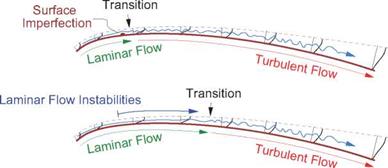Transition
The average skin friction chart in Figure 4.28 indicates that the transition location has considerable influence on the profile drag of an airfoil or body, and often affects maximum lift as well. For boundary layer calculation purposes, the transition point is where a switch is made from a laminar to a turbulent calculation method. It is therefore necessary to determine the transition point in terms of laminar boundary layer quantities and other relevant parameters. Since transition prediction is a large field, only a few key results can be given here. See Reed et al [35] for an overview.
1.12.3 Transition types
Transition is in most cases initiated by some sort of unsteady external freestream disturbances, or by surface vibration which oscillates the entire flow. How the outside disturbances enter the boundary layer is known as the receptivity problem (see Saric et al [36]). The subsequent mechanisms which make these initial disturbances trigger transition can be grouped into three broad types, shown in Figure 4.30.
 Forced Transition
Forced Transition
![]()
Natural Transition
Figure 4.30: Main types of transition. [3] [4] [5]
sufficiently strong to enter the boundary layer almost everywhere. Examples are flows found inside turbomachinery. Chaotic turbulent flow in a boundary layer on a turbomachine blade airfoil will begin where the local Reynolds number Reg becomes sufficiently large to allow the turbulence to be sustained. This minimum value is in the range Reg > 150 … 250, depending on the local shape parameter H. The method of Abu-Ghannam and Shaw [39] has been popular for predicting bypass transition, especially in turbomachinery flow applications.











